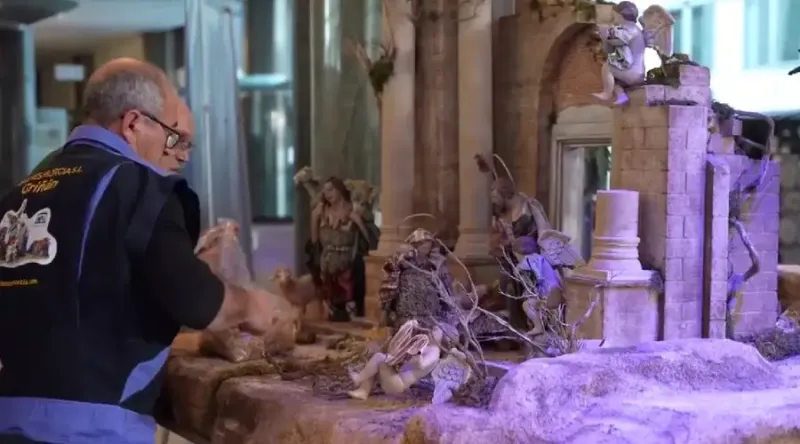 It’s the most wonderful time of the year for watching Christmas classics on TV. / Shutterstock
It’s the most wonderful time of the year for watching Christmas classics on TV. / Shutterstock
CNA Staff, Dec 20, 2021 / 14:14 pm (CNA).
Christmastime is upon us. In the spirit of the holiday, the writers and editors of CNA would like to share some of their favorite Christmas movies — and where you can find them. Merry Christmas and happy viewing!
The Muppet Christmas Carol
Several serious-minded movie critics have spoken about this winsome 1992 adaptation of Charles Dickens’ timeless Christmas story in the same breath as “Casablanca” and “Citizen Kane.” To be clear, all of those critics happen to be members of my immediate family. But still. Academy Award-winner Michael Caine (Ebenezer Scrooge) deserved another Oscar for being such a good sport in allowing a bunch of adorable puppets to upstage him in every scene of this family-friendly movie. Gonzo (as Dickens, narrating the tale) and Rizzo the Rat (his sidekick) account for most of the best one-liners and sight gags (Rizzo: Boy, that’s scary stuff! Should we be worried about the kids in the audience? Gonzo: Nah, it’s all right. This is culture!) You’ll love the song-and-dance number, at turns spooky and hilarious, by Statler and Waldorf, as the ghosts of Scrooge’s former partners, Jacob and Robert Marley (Robert Marley: More gravy than of grave? Jacob Marley: What a terrible pun. Where do you get those jokes?) Available on Amazon Prime, Disney+. (Rated G)
— Shannon Mullen, Editor-in-Chief
Merry Christmas (originally Joyeux Noël)
This is a very moving account of the famous “Christmas Truce” of 1914 in the French-German trenches during World War I. The French movie was released in 2005, and it is a tearjerker, so bring your tissues. Available in English on Apple TV and Google Play.
— Alejandro Bermudez, Executive Director, ACI Prensa and CNA
Elf
No matter how many times you watch this fish-out-of-water comedy, it will still make you laugh. While the movie is not overtly religious, the eponymous character, Buddy (Will Ferrell), is a believer in an unbelieving world, suffering the trials and misadventures of someone who perceives a world beyond the everyday. Indeed, the plot culminates (spoiler alert) in a test of faith. When his sleigh crashes in Central Park, Santa explains to onlookers that his “Clausometer” is dangerously low and he needs a fresh supply of Christmas spirit to be airborne again. “Christmas spirit is about believing, not seeing,” he says, perhaps echoing St. Paul’s definition of faith in Hebrews 11:1. And just when Santa needs it most, a man of faith in yellow stockings and a pointy hat steps forward… Available on Amazon Prime Video, Google Play, YouTube, and Vudu. (Rated PG)
— Luke Coppen, Europe Editor
The Small One
A young boy must sell a cherished but aging donkey, named Small One, to support his poor family. Will he find a worthy owner for his four-legged friend in the rough streets of Nazareth? Or will Small One end up in the slaughterhouse? At only 26 minutes runtime, this is a kid-sized movie, but there’s enough action, comedy, and emotion to satisfy all ages. The movie’s title song is simple but inspirational, a worthy addition to any child’s repertoire. The lyrics and melody might even spare the ears of parents weary of recent kids’ movies. In the great Disney tradition, “The Small One” is visually beautiful. It’s from 1978, part of a decade that many Disney fans forget. Movie director Don Bluth would later win fame for his full-length animated movies like “The Secret of NIMH,” “An American Tail,” and “All Dogs Go to Heaven.” The story is drawn from a book of the same name by the children’s author Charles Tazewell. He wrote “The Littlest Angel,” a sentimental and popular, if theologically questionable, children’s book. This Christmastime donkey flick is far from asinine. Watch the whole thing for a Christmas surprise. Available on Disney+. (Rated G)
— Kevin J. Jones, Staff Writer
A Muppet Family Christmas
There’s no Michael Caine in this one, but there’s a whole lot else: the original Muppets; the Sesame Street crew; Fraggles, and even Maureen the Mink. It’s truly not the Christmas season until I’ve watched a number of Muppets repeatedly slip and fall over an icy patch at Fozzie’s mom’s house. While this movie is often overshadowed by that other Muppet Christmas special, it is still a solid inclusion in the Christmas movie canon. The movie tells the tale of Fozzie’s good-intended (but ill-planned) attempt to surprise his mother for Christmas — and the ensuing hijinks that blew in with the worst blizzard in half a century. First released in 1987, “A Muppet Family Christmas” has aged like a fine wine, and still makes me chuckle in 2021. (Barometers are falling sharply!) At just under 48 minutes, it’s the perfect length movie for when you need a little Christmas, but don’t want to settle down for over an hour — or if you need something to do while cookies are in the oven. Available on YouTube. Look out for the icy patch! (Rated TV-PG)
— Christine Rousselle, Washington, D.C. Correspondent
It’s a Wonderful Life
Unappreciated when it first came out in the 1940s, but gaining status as one of the most perennially rewatched Christmas movies of all time, “It’s a Wonderful Life” really does live up to the descriptor in its title. If, somehow, you’ve managed to never see it, it’s the story of a smart and ambitious small town guy, George Bailey, who for a variety of reasons never manages to escape his provincial life and travel the world like he had always planned. When a seemingly insurmountable disaster besets George on Christmas Eve, he wishes he had never been born — a wish that, thanks to a friendly angel named Clarence, suddenly comes true. Try not to shed a tear during the final scene. I dare you. Available on Amazon Prime and YouTube. (Rated PG)
— Jonah McKeown, Producer/Writer
A Charlie Brown Christmas
When I was growing up, we watched this Peanuts classic every year to kick off the Christmas season. Now, as an adult, it’s part of my own Christmas traditions. The movie is a great reminder of the real meaning of Christmas, with the Nativity story embedded into the script. I find that each time I watch it, I’m invited to a deeper realization that Christmas is really about the coming of Christ, and not the material or commercial things we get wrapped up in (pun intended) this time of the year. Available on Apple TV+ for subscribers. (Not Rated)
— Autumn Jones, Staff Writer
The Polar Express
This 2004 animated film is about a group of young children who take a mystical train ride to the North Pole on Christmas Eve. The movie focuses on the struggle of two boys to believe in Santa Claus, because they have never seen him. But once they arrive at the North Pole, they are entrenched in an adventure like never before, culminating in (spoilers!) meeting the big man himself. The movie, which features the voice of Tom Hanks, was nominated for three Academy Awards. Available on HBO, Amazon Prime Video, Hulu, and Netflix. (Rated G)
— Joe Bukuras, Staff Writer
Home Alone
This 1990 classic tells a Christmas story that the whole family can enjoy: What happens when an 8-year-old is left to his own devices to protect his home, alone, against a pair of burglars? Kevin McCallister’s family accidentally leaves him behind in Chicago as they venture on a family vacation abroad. Kevin (played by Macaulay Culkin) takes charge and rigs his home with booby traps. On Christmas Eve, he treks through the snow and comes to a halt as he spies an outdoor nativity scene and hears strains of “O Holy Night” escaping the nearby church. He enters and encounters two saviors: Jesus, and an elderly man he learns not to judge. Home Alone is a story about family, friendship, and the difference that one person — even a small one — can make. Available on Amazon Prime, Disney+, Google Play, iTunes, Vudu, and YouTube. (Rated PG)
— Katie Yoder, Washington, D.C. Correspondent
[…]







A nativity scene admitted into the lofty offices of the European Union!
Like the first lunar landing (“a small step for man, a giant leap for mankind”), this small step is a giant leap away from the cancel culture and longer-term amnesia…In A.D. 496 Clovis was baptized, and Gaul (the land of the Franks) became France, “the eldest daughter of the Church.” And “the rest is history”–the marriage of Classical-world learning with our transcendent Christian heritage. That is, the rest is history until the secularist superstructure created the European Union (EU) ex nihilo on Nov. 1, 1993 (also All Saints Day!).
A union which elides the existence of one of its parents! In the Charter of the EU the Classical heritage is noted, but not the Christian. A test-tube baby might as well claim asexual reproduction like rabbits.
So, now, as an anti-Christian 7th-century aberration and 21st-century post-Christian irrationalism, both, challenge the combined and fecund Classical and the Christian roots of the real Europe–a cultural reality more than only geographic–it seems only fitting to concede to reality at least this symbolic gesture. So, the most recent three decades again take note of the past fifteen centuries and more…while self-appointed elites still market their bromides, and the czar and the caliph are pounding on the door.
On what basis, our intrinsic and real human rights?